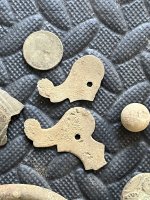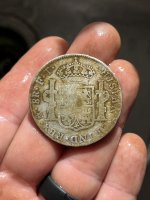BamaBill
Hero Member
- Nov 8, 2006
- 686
- 16
- Detector(s) used
- Minelab X-terra 70, AT Pro, Tesoro Tejon, ML X-terra 50
- Primary Interest:
- Relic Hunting
On another forum a respected member of that forum dished out a heavy condemnation of the machines that use a visual readout to identify targets or a tone system to help identify same. He said you cannot trust most of what these machines are telling you because they're designed to identify targets in air, but not as well in ground. Many of the good targets we leave in the ground are because of an incorrect ID of iron. If this is true, what I want to know, if if an LCD-type readout machine cannot be trusted to correctly identify targets, at least 50% of the time, what use is Target identification? If you have to dig most of the metal targets because of uncertainty, of what use is discrimination or target ID? I started with a 1 tone machine and while learning I was digging a lot of my targets and found an enormous amount of trash. I got a TID so that I could gather more information and hopefully, eventually cut down on the amount of trash. If what he says is true, I would be better off going back to a 1 tone machine and digging most of my trash. Its true that I'm not finding a whole lot more good targets with the TID machine, but I figured it was because I haven't gotten any plum opportunities. If anyone agrees with the assertion that TID machines are basically a waste, I would really love to hear why you can't eventually learn the machine well enough to make full use of the promise that TID seems to offer.
Amazon Forum Fav 👍
Upvote
0


 When I swipe left to right and get a reading that is the same or within 1 digit on the return pass 99% of the time it is a good item and not trash. Just more information to decide whether to dig. In trashy sites digging every hit gets old after about an hour.
When I swipe left to right and get a reading that is the same or within 1 digit on the return pass 99% of the time it is a good item and not trash. Just more information to decide whether to dig. In trashy sites digging every hit gets old after about an hour. 

 Needless to say, it didn't take long for the reality to sink in: There's still an aweful lot of aluminum junk that perfectly mimics gold rings! Doh! So during this time, several of us began to mock these TID units. And to this day, as Bama-Bill pointed out, people still do. Sure they're not exactly perfect! All they do is show conductivity, not actual composition. BUT, back in the mid-80s, we began to see a curious phenomenom play out: those guys with these newfangled TID machines were inevitably coming in with the better finds to the monthly meetings. It still didn't make sense to me (I still had non-TID machines). I would reason: "how stupid is that? You're going to dig it anyways, so why not just look at it when you dig it up?" or "I can reject tabs too, by just increasing the knob on my disc. control, so what?".
Needless to say, it didn't take long for the reality to sink in: There's still an aweful lot of aluminum junk that perfectly mimics gold rings! Doh! So during this time, several of us began to mock these TID units. And to this day, as Bama-Bill pointed out, people still do. Sure they're not exactly perfect! All they do is show conductivity, not actual composition. BUT, back in the mid-80s, we began to see a curious phenomenom play out: those guys with these newfangled TID machines were inevitably coming in with the better finds to the monthly meetings. It still didn't make sense to me (I still had non-TID machines). I would reason: "how stupid is that? You're going to dig it anyways, so why not just look at it when you dig it up?" or "I can reject tabs too, by just increasing the knob on my disc. control, so what?".  I was using a Whites Eagle at the time, and, as you know, it has a 1 to 95 scale. I set it to reject everything from 46 down. 46 was approximately where the larger beefier square tabs come in, so it left me with most junk tuned out, and most coins tuned in, and a happy compromise for target "averaging". Imagine my surprise when I found a $5 gold piece! My immediate thought was "wait, I thought I had gold and low conductors tuned out?". So I waived it over the coil to see where it reads: 47/48-ish! Yup, a single digit or two higher on the disc, and I would've lost it. Any lower on the disc, and I'd have spent 4 days digging tabs. So you can see how a tiny imcrement of TID pays off, in a micro-situation like this. Bear in mind that this is just one junky scenario, and in relicky situations, you can just elect to dig all, even if flitty, low, etc...
I was using a Whites Eagle at the time, and, as you know, it has a 1 to 95 scale. I set it to reject everything from 46 down. 46 was approximately where the larger beefier square tabs come in, so it left me with most junk tuned out, and most coins tuned in, and a happy compromise for target "averaging". Imagine my surprise when I found a $5 gold piece! My immediate thought was "wait, I thought I had gold and low conductors tuned out?". So I waived it over the coil to see where it reads: 47/48-ish! Yup, a single digit or two higher on the disc, and I would've lost it. Any lower on the disc, and I'd have spent 4 days digging tabs. So you can see how a tiny imcrement of TID pays off, in a micro-situation like this. Bear in mind that this is just one junky scenario, and in relicky situations, you can just elect to dig all, even if flitty, low, etc... 





